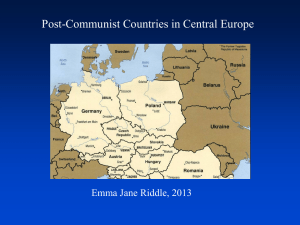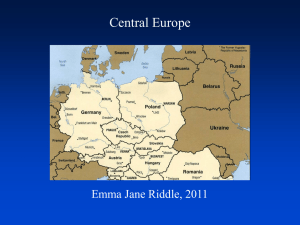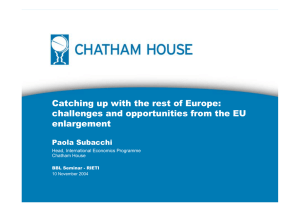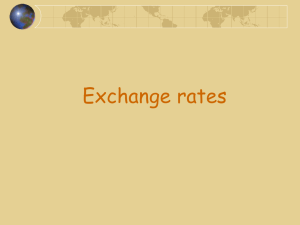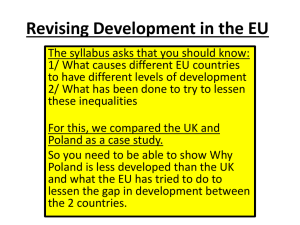European Union Today
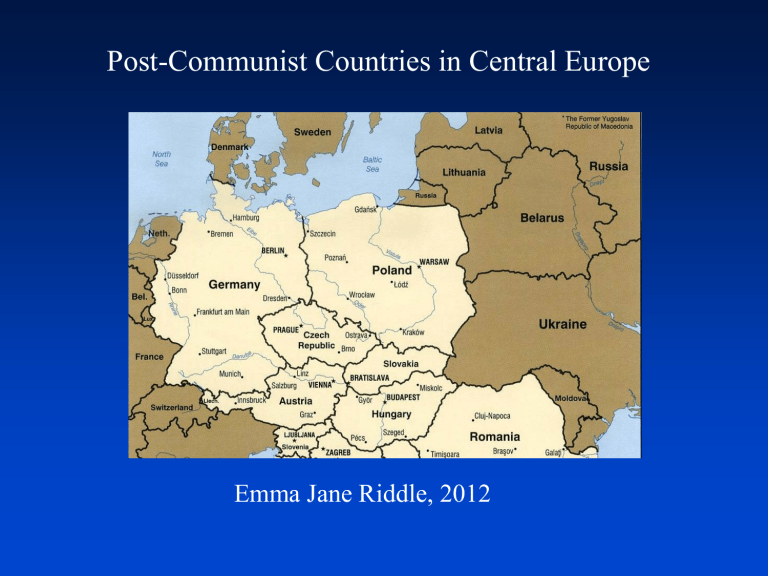
Post-Communist Countries in Central Europe
Emma Jane Riddle, 2012
Overview
• Statistics: population and GDP
• After Communism, What?
– The European Union and the euro currency
• Economic growth in this area
• Economic developments since 2008
• Business culture in Poland
• Managing employees in the Czech Republic
Population (Millions)
2011 Estimates
Slovenia
Slovakia
Poland
Hungary
Czech Republic
0
2,0
5,5
38,4
9,8
10,2
5 10 15 20 25
Population (millions) - 2011 Estimate
30 35 40
U. S. Population = 314 Million
Gross Domestic Product (Billion $)
2011 Estimates
Slovenia
Slovakia
49,6
96,1
Poland
Hungary 140,3
Czech Republic
0 200
215,3
300 100 400
GDP (Billion U. S. $) - 2011 Estimate
500
513,8
600
U. S. GDP = $15.09 Trillion = $15,090 Billion
GDP Per Capita (Thousand $)
(Purchasing Power Parity)
Slovenia 29,1
Slovakia
Poland
23,6
20,6
Hungary 19,8
Czech Republic
0 10 20
GDP Per Capita (Thousand $), PPP
2011 Estimate
27,4
30 40
U. S. GDP Per Capita = $49,000
GDP Growth Rate (%) - 2011
U. S. GDP Growth Rate – 1.7%
Communism in Europe
1945 - 1989
• Soviet Union
• Soviet bloc countries: Czechoslovakia, Hungary,
Poland, East Germany, Bulgaria, Romania
• Yugoslavia, including present-day Slovenia
• Albania – allied with China
After Communism, What?
• Democracy
• Prosperity
– Market economy
– EU membership
– World Trade Organization (WTO) membership
– Euro currency (still in the future for some)
• Security: NATO membership
• These goals promoted political, economic, and cultural change.
Requirements to Join the EU
• Be a stable democracy, respecting human rights, the rule of law, and the rights of minorities.
• Have a functioning market economy that can compete in the EU.
– Many state enterprises were privatized.
– Foreign investment was needed to develop the economies.
• Adopt EU laws, product standards, and regulations.
• The five central European countries joined the EU on
January 1, 2004.
European Union (EU) Before 2004 Enlargement
European Union Today
• 27 member countries
• Croatia is scheduled to join in 2013
• Candidate countries
• Turkey
• Macedonia
• Montenegro
• Iceland
Benefits of EU Membership
• Ability to export to other EU countries, with no tariffs charged.
• Citizens of an EU country can live, work, and study in any EU country.
• Economic development aid from the EU
• Easier to attract foreign investment
Higher Education
• Mixture of public and private universities
• Higher education in the European Union
– Five-year Master’s degree program
– Three-year Bachelor’s degree program
– Two-year Master’s completion program
– After completion of a Master’s degree, a doctorate can be completed in three years.
• European Credit Transfer System (ECTS)
Requirements to Use the Euro Currency
• Stable consumer prices – low inflation
• Government budget deficit <= 3% of GDP
• National debt <= 60% of GDP
• Stable long-term interest rates
• Value of the national currency must be stable relative to the euro
• Slovenia and Slovakia use the euro
Economic Growth in Central Europe
• Automobiles and parts
• Financial services
• Information technology
• Internet services
• Tourism
• Transportation, distribution
Economic News Since 2008
• In 2009, Poland was the only country in the EU to have growth in real GDP.
• Hungary had a financial crisis.
– Real estate bubble, financed by loans that had to be paid back in euros
– The Hungarian forint lost value, relative to the euro
– Many people could not pay off their loans.
Threats to Democracy in Hungary
• The central bank is now under political control.
• Judges were forced to retire at age 62, instead of 70.
• The head of the National Judicial Office names all new judges.
• Public television is being told what stories to cover, whom to interview, and what not to cover.
• The Media Council recently cancelled the license of an independent television station.
• The Media Council can fine media outlets with whom it disagrees.
Business Culture in Poland
• Design products for Poland.
• Win-win negotiations work well.
• Be prepared to provide data. People are not impressed by "sales talk".
• Take time to build relationships and gain trust.
• Be willing to "give something back" to the community.
Business Culture in Poland (2)
• Local governments have a large role in business regulation. Some areas are more conducive to business than others.
• Professional titles are used in Poland.
Example: engineer
• Do not call older people by their first names until you are invited to do so.
• Business entertainment should be reciprocated.
• People are reluctant to share personal information.
Managing Czech Employees
• Establish a good rapport with employees.
• Managers must be trustworthy and credible
• Younger Czech employees
– Are eager to learn and often creative
– Want work that is meaningful and appreciated
– Want opportunities for professional development
• Some older Czechs may lack motivation and are not accustomed to taking initiative
Managing Czech Employees (2)
• Czechs may be reluctant to tackle new responsibilities because
– They tend to be perfectionists.
– They don’t want to lose the respect of colleagues by making a mistake.
• Many Czechs do not like to take risks.
– Responsibilities and work procedures should be clear.
• People are reluctant to share personal information.
Source: Karin Genton-L’Epee, Prague Post , Jan. 6, 2005
